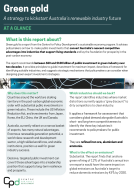
Green gold is a report from the Centre for Policy Development’s sustainable economy program.
It advises policymakers on how to make public investments that convert Australia’s nascent competitive advantages into industries that support living standards and lay the foundation for prosperity in the post-carbon economy.
The report recommends between $60 and $100 billion of public investment in green industry over two decades.
It provides principles to guide investment for maximum impact, describes a framework for identifying suitable industries, and suggests strategic mechanisms that policymakers can consider when designing green export investment strategies.
Why does this matter?
Countries around the world are staking territory in the post-carbon global economic order with substantial public investments in green industry. These include the US Inflation Reduction Act, and investments from Japan, Korea, the EU, China, the UK and Canada.
Australia, currently reliant on a narrow basket of exports, has many natural advantages. Enormous renewable generation potential, a world-class research and development sector, a high-skilled workforce, and stable institutions, position us well for green industry success.
Decisive, targeted public investment can covert these advantages into a leadership position that supports long-term resilience and prosperity.
Which industries should we back?
The report identifies three industries where market distortions currently apply a “grey discount“ to dirty competitors to clean industry.
It applies a framework for assessment that considers global demand alongside Australia’s short- and long-term competitiveness to identify the three key industries it recommends to policymakers for public investment.
They are refined iron ore, aluminium and ammonia.
What is the effect on emissions?
The report finds that onshore green refining of 12% of Australia’s annual iron ore exports would have the same impact on global emissions as Australia’s target to reduce domestic emissions by 43% by 2030.
What principles should guide public investment?
Public investment should be strategically designed and targeted to ensure impact. The report suggests that beyond careful industry selection, investment should:
- Ensure additionality, avoiding public support for actions that would have been taken anyway
- Reduce economic risk to catalyse private investment in green export industries
- Address the “grey discount” that market distortions currently apply to some dirty products
- Encourage technology deployment and innovation to hasten commercial application of new green technologies
- Be “front-loaded” to secure momentum during a critically competitive period to establish green industries and reduce emissions globally
- Be designed to phase out and avoid creating commercial industries that have an ongoing reliance of public spending for survival
- Be simple and clear for market participants
- Enable public investors to capture upside so that returns on public investments can be reinvested in the national interest
What else do we need?
Australia can become a green industry superpower. Getting there means dramatically expanding our renewable energy generation – maybe to 10 times the current national electricity market (NEM).
Other challenges include managing workforce readiness and mitigating inflationary risk.
The paper also notes that other measures unrelated to export industries are necessary, such as subsidies for domestic consumers, household electrification and efficiency, community development, climate adaptation, and environmental protection.






